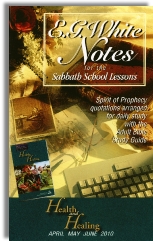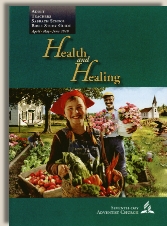|
||||||||||||||
Commentary on "Celebrating Spiritual and Physical Fitness"
Day 4: Tuesday, April 13, 2010
Overview
Apart from Friday’s lesson which is the shortest by definition, today’s lesson is the shortest in the entire week, dealing with only one single aspect of faith: “faith without seeing”.
The lesson begins with the story of a young officer whose duty prevented him from being present for his mother’s surgery for breast cancer. He was disappointed that God had seemingly not answered his prayers for God to heal his mother, and he took this as a proof against his faith in God’s existence and benevolence toward himself. He found his faith refreshed when he recounted Thomas’ experience with lack of faith after the resurrection of Jesus and Jesus rebuke, “Blessed are those who have not seen and yet have believed,” (John 20:29). This point the authors of the lessons amplify to the degree that it sounds like any proof or “proof” as they put it, in the quotation marks, is seen as unnecessary and even detrimental to faith. The readers are exhorted to believe based exclusively on God’s word and their previous experiences with Him and make abstraction of external circumstances.
Observations
To a certain degree, the authors are right. Trust in God’s word in the face of hostile circumstances is certainly a commendable thing. Believers put their trust in God and Christ despite the apparent lack of involvement from God in their lives. Nevertheless, their belief does not lack substance; even the authors speak of trusting in God “based on what we have already experienced”, based on God’s interventions in the past in believers lives. Still, after they had begun so well with Thomas’ example, the authors don’t deal with the central issue of faith.
Thomas was rebuked not because he disbelieved Christ’s resurrection without proof. Indeed, he had the apostles’ testimony about it, and his brothers until that point had proven to be trustworthy witnesses. They were, after all, the last people on earth to believe Christ’s resurrection if there had not been solid reasons and proofs for it. In their disappointment over Jesus’ apparent failure to fulfill their expectations, they entered such a psychological state that nothing less than the actual resurrection could have changed their despair into faith. Thomas was not without proof, albeit it was indirect proof coming from trustworthy witnesses and circumstances. It was the kind of proof that believers are exhorted to trust today, when Jesus blessed those who believed “without seeing.” Thomas’ failure was not an inability to believe without proof but a failure to believe based on the indirect but solid proofs he already had. He was looking for a different kind of proof in order to satisfy his own standards of certainty. This situation reveals a human problem, not a problem with God’s revelation.
The failure of the authors of the quarterly to comprehend this dimension of Thomas’ lack of faith has serious consequences for the kind of faith they advocate for their readers. The only “proof” they offer for their readers is the readers’ personal and subjective experiences disconnected from the biblical record of Jesus life, death and resurrection. It is the biblical record which is essential for the Christian faith. Perhaps this failure is not entirely unintentional because there is a certain difference between Christian faith based on biblical, historical facts which are public and the Adventist faith which is based on facts that are not public and not open to verification.
For example, the alleged 1844 event with the supposed change in Christ’s ministry in the heavenly sanctuary is not attested by any historical or public facts. It is a belief without any kind of proof. People are supposed to believe the reality of this event based on one single testimony coming from a single witness: Ellen White, who was a witness in vision of what supposedly happened on 22 October, 1844. While this is not entirely irrational, the question may be asked is she a witness as trustworthy as the apostles were? She would have to be in order for people today to believe in such a watershed event. Research of her writings clarifies that she is not a trustworthy witness because she changed her testimony about the event that happened on 22 October ,1844. It’s worthy to remember that the apostles never changed their testimony about what happened that Sunday after the crucifixion. In contrast, Ellen White spoke about Christ’s ceasing to minister for the entire world in the sanctuary above, stopping the saving of sinners who were unconverted to the Millerite message until 22 October. She advocated on the basis of her vision the teaching known as the “shut door” teaching, a message that she abandoned after 7 years, around 1851. She modified her published writings about the event in order to remove the elements that were unfavorable to her new testimony. Moreover, her initial testimony was different than her later account of events. Beside this event, there are other proofs about her unreliability as a trustworthy person,. Her plagiarism and her attempts to hide it don’t encourage belief that she was a reliable witness.
There are no historical proofs in favor of the Adventist belief that something significant happened in 1844. Actually, while Christ’s resurrection validated all He claimed about Himself and about His mission, what happened on 22 October, 1844, invalidates Adventism’s claims. While Christ predicted that he would die and rise again and his predictions came to pass, the predecessors of the current Adventists, the Millerites, predicted the second coming to be the event of 22 October, 1844. The fact that Jesus did not return on that date stands in stark contrast to the revelation of God in history. His predictions about Jesus’ resurrection were proved by the event itself. In the Adventists’ case, the faith required is a faith that not only lacks solid historical proof, but it actually requires a faith that goes against the historical proofs that invalidate the claims of the Adventists.
In the final instance, it is no wonder that the authors of the quarterly advocate a faith that is not founded on historical facts attested by reliable witnesses but is actually contradicted by the historical account. It stands in stark contrast with the Christian faith in the event of the resurrection with which Thomas had failed to deal adequately. Adventism requires blind trust in a witness that is self-contradictory in its testimony and it is not confirmed even by the experience of current Adventist believers. In fact, what is currently claimed to be the true event of 1844 invalidates the testimony of the eye-witness of that moment, Ellen White, who said in 1850, “But now time is almost finished, and what we have been years learning, they will have to learn in a few months.” Not only months, but many years have passed since that prediction.
Moreover, the current experience of the members of the Adventist church cannot attest to what happened in 1844. It was claimed that this date starts the cleansing of the sanctuary with the parallel cleansing of sin in the people of God—the remnant—who were supposed to demonstrate obedience all the Ten Commandments and to exhibit a superior morality to that of the apostate churches of Babylon. The failure of “the remnant church” to demonstrate this obedience and superior morality invalidates their claim that the “1844 doctrine” really happened. Instead, the lack of this moral perfection demonstrates that their explanation of October 22, 1844, is faulty. Although such perfection may be a future reality, at the present time this experience cannot be used as proof for Adventism’s claim of being the remnant: those who keep the commandments of God.
This faulty reasoning suggests instead that the only faith an Adventist can put forward is a faith that is so radically different from true Christian faith in Christ and in his work that it can hardly be called rational. Rather, it’s a leap in the dark without any connection with historical facts. On the contrary, the facts work rather against them, and their faith falls in the domain of irrational beliefs.
Summary
- Thomas did not lack evidence for believing in the resurrection.
- The apostles’ witness was sound evidence because they had a history of proving themselves trustworthy.
- Thomas’ lack of first-hand evidence is not the same as the Adventists’ first-hand evidence in the 1844 event.
- Thomas heard the other apostles’ witness that Jesus was alive.
- Adventists hear Ellen White’s witness that Jesus changed His ministry in heaven in 1844.
- Ellen White has been proven to be both a plagiarist and to contradict her own testimony. She is not a witness in the same category as the apostles.
- The lesson calls for the reader to believe based on personal experience with God.
- The Christian faith never calls for blind belief but rather for faith based on hearing the word of God in Scripture.
- The word of a “modern prophetess” cannot be compared to the word of God, nor can a person’s subjective experience with God be considered valid evidence for belief.
- Belief must be grounded in Scripture; anything less is not trustworthy.
- Believing without seeing means believing what God has revealed in the Bible. It does not mean believing based on experience.
Copyright 2010 BibleStudiesForAdventists.com. All rights reserved. Revised April 12, 2010. This website is published by Life Assurance Ministries, Glendale, Arizona, USA, the publisher of Proclamation! Magazine. Contact email: BibleStudiesForAdventists@gmail.com.
The Sabbath School Bible Study Guide and the corresponding E.G. White Notes are published by Pacific Press Publishing Association, which is owned and operated by the Seventh-day Adventist church. The current quarter's editions are pictured above.
Official Adventist Resources
Standard Edition Study Guide Week 3
Teacher's Edition Study Guide Week 3
Easy Reading Edition Study Guide Week 3
Search the Complete Published Ellen G. White Writings


